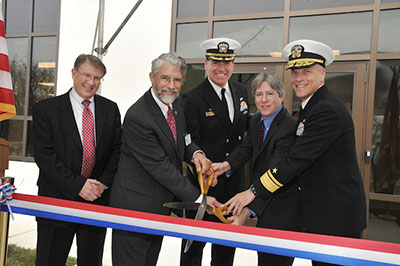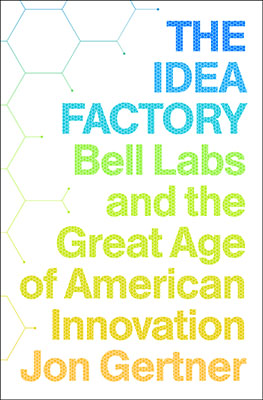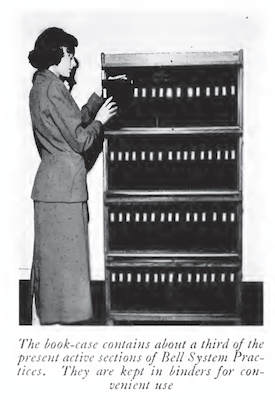Despite Bruno Latour’s provocation that “nothing special” happens in laboratories,[1] scholars of science and technology continue to be fascinated by them. And for good reason: laboratories, after all, are crucibles for inventions and innovations. In an age like ours where innovation-speak reigns, could there be any more urgent task than to understand the sources of inspiration and discovery?[2]
Yet our affinity for innovation has a corresponding dark side that manifests in indifference toward existing technological systems. As a scholar and as a citizen, it is this indifference that concerns me most: rather than fixating so much on innovation and discovery, I wish we would spend more time thinking through the dynamics of standardization, infrastructure, and maintenance. The neglect of infrastructure, for example, is especially evident in public policy, as the comedian John Oliver showed in a recent rant. Oliver boiled the issue down to its tragicomic essence: we need public funds to maintain old technologies such as bridges and dams, but our elected officials prefer to break out their oversized scissors and celebrate something new.


Images: John Oliver on Last Week Tonight, via YouTube.com (top); Ribbon cutting at the U.S. Naval Research Laboratory, March 2012 (bottom)(photo credit: Jamie Hartman, public domain).
To put the point another way: Americans would rather dream about smart cities than throw money into stupid potholes. The underlying dynamic here—fascination with the new, neglect of the old—is, itself, nothing new. It is common for historical accounts of technology to emphasize invention and innovation, a tendency that David Edgerton attacked in his remarkable 2007 book The Shock of the Old. Edgerton urged his readers to pay closer attention to technologies-in-use, to shift their attention from the spectacular to the mundane, to rethink the meaning of the terms “significant” and “important,” and, in the process, to reconsider the range of human, military, and capitalist engagements with technology.
Edgerton’s challenge amplifies a dispersed yet powerful literature by scholars working in a variety of fields including anthropology, sociology, STS, history, public health, architecture, and more. In this literature we can delve into the practices of classification, the sociology of maintenance and repair, and rich ethnographic accounts of routine labor in all kinds of material and digital systems. One could read this literature as a set of counternarratives to tales of heroic innovators—sketching the outlines of a people’s history of technological systems.[3]
I locate my own research within these counternarratives, especially those that focus on the phenomena of standards and infrastructure. These topics are fascinating because they push us to consider the durability and frailty of the human-built world. Groups of people create standards to guarantee reliability, especially under conditions of duress; the infrastructures they design can be deemed successful only when they can be taken for granted. Standardization and infrastructure, maintenance and repair: these are the yin to innovation’s yang.
One brief example from my research illustrates the types of stories and narrative choices that we encounter when we take Edgerton’s challenge seriously—that is, when we foreground standards and infrastructure and set innovation to the side.[4]
An Anonymous History of the Bell System
My example begins by returning us to the laboratory—to Bell Labs in particular, that citadel of invention, and subject of Jon Gertner’s The Idea Factory, a book whose subtitle declares Bell Labs to be the driver of the Great Age of American Innovation.[5] Bell Labs was born in 1925, when AT&T President Harry Bates Thayer decided that the system’s growth and complexity required a special home for research. Six years earlier, Thayer had divided AT&T’s engineering staff in half: the Department of Operations and Engineering and the Department of Development and Research. The distinction, Thayer later wrote, allowed Bell System personnel to “differentiate in our work between the engineering of the present and the engineering of the future.”[6] The creation of Bell Labs thus was a corporate and institutional expression of the split between high-status laboratory research and the mundane business of network operations and maintenance.


Images: Bell System logo, 1921 (top), via Wikimedia Commons; The Idea Factory by Jon Gertner (bottom).
Both teams of engineers performed remarkably well for decades to come. The engineers of the future at Bell Labs, flush with the bounty of AT&T’s monopoly rents, reveled in a free-flowing environment for research that was the envy of the world. Historians, journalists, and corporate public relations staff have documented with great care the discoveries that flowed from the “Crown Jewel”: radio astronomy, the laser, the transistor, information theory, UNIX, and other accomplishments that yielded eight Nobel Prizes. [Conveniently, as I was writing this blog post, AT&T posted a Bell Labs nostalgia video, promoted by Gizmodo under the headline What It Was Like to Work at the Birthplace of Cellphones and Lasers.]
Dazzled by Bell Labs, historians (and journalists and policymakers) tend to ignore the scope and significance of the people working throughout the rest of the Bell System.[7] It was these people—including the engineers of the present in AT&T’s Department of Operations and Engineering—who presided over the system that provided Americans with the best and most reliable telephone service in the world.
Some numbers can help convey the depth and scale of their work. First, the system they built and maintained grew at an astonishing rate in the mid-20th century. In 1945, 46% of American households had telephone service. That portion grew to 79% in 1960 and 96% in 1980. The total number of Bell telephones in service grew from around 20 million in 1940, to 63 million in 1960, to 145 million in 1980.[8]
Second, Bell System engineers codified and standardized along every dimension imaginable, from core functions such as signal transmission and underground cables to seemingly peripheral details such as cutlery, medical supplies, manhole covers, and office furniture. By the 1980s, the index alone of these standards, known as the Bell System Practices, filled 969 pages; the printed standards themselves filled over 80 cubic feet of shelves.[9] The Bell System was under near-constant scrutiny from antitrust regulators, but its engineers did not see their program of standardization as oppressive or anticompetitive. Instead, as Frank Jewett summarized in 1915, they believed “what we are actually trying to do by our standardization work is to develop the telephone art in the best way that we know how to develop it.”[10]


Images: Bell Telephone Magazine, courtesy of the TCI Library, public domain (top); Photo by author (bottom), Creative Commons 4.0 Attribution.
Third, in terms of sheer human effort, the engineers of the present and maintainers of the system far outnumbered the engineers of the future at Bell Labs. In 1960, for example, Bell Labs employed around 12,000 people—roughly 1.6% of the 735,000 people who were employed by the Bell System. By comparison, over 140,000 people worked at Western Electric, the manufacturing arm of the Bell System; and over 500,000 people worked in the rest of the system—in long distance, local operating companies, engineering, and other AT&T General Departments.[11]
Innovation Studies: STS for the 1%?
Stories about technology that revolve around geniuses, labs, and innovation efface the everyday labor of the technological workforce. They leave us with a strangely distorted view of the production and provision of technological systems. Readers of Gertner’s Idea Factory will delight in stories about the 1.6%—such as Claude Shannon’s juggling and unicycling—but they will learn little about the other 98.4%: technicians who repaired broken switches and cables, factory workers who spent thousands of hours designing and testing equipment, and engineers who devised standards to protect the system and its users from sleet storms, lightning strikes, and everyday accidents. Unlike some of their colleagues in Bell Labs, these workers didn’t have the luxury of sleeping on the job in the name of “innovation.”
I understand the widespread fascination with self-driving cars and transhumanist adventures to outer space, and I recognize that these topics make for better clickbait and blockbuster films than tales of standardization and maintenance. I also understand why a book called The Innovators: How a Group of Hackers, Geniuses, and Geeks Created the Digital Revolution is a best-seller, but a book called The Maintainers: How a Group of Bureaucrats, Standards Engineers, and Introverts Made Infrastructures That Kind of Work Most of the Time is more likely to exist only as a parody. Nevertheless, I continue to believe that scholars can do a better job of connecting with readers who care about the lives and labor of the 98.4%.
Footnotes
[1] Bruno Latour, “Give me a laboratory and I will move the world,” in Karin Knorr-Cetina and Michael Joseph Mulkay, eds., Science Observed: Perspectives on the Social Study of Science (Sage Publications, 1983): 160.
[2] Lee Vinsel, “How to Give up the I-Word, Pt. 1,” Culture Digitally, September 22, 2014, available from http://culturedigitally.org/2014/09/how-to-give-up-the-i-word-pt-1/; Lee Vinsel, “How to Give up the I-Word, Pt. 2,” Culture Digitally, September 23, 2014, available from http://culturedigitally.org/2014/09/how-to-give-up-the-i-word-pt-2/; Amanda Moore McBride and Eric Mlyn, “Innovation Alone Won’t Fix Social Problems,” The Chronicle of Higher Education, February 2, 2015, available from http://chronicle.com/article/Innovation-Alone-Won-t-Fix/151551/.
[3] See for example Geoffrey C. Bowker and Susan Leigh Star, Sorting Things Out: Classification and its Consequences (MIT Press, 1999); Christopher Henke, “The Mechanics of Workplace Order: Toward a Sociology of Repair,” Berkeley Journal of Sociology 44: 55-81 (2000); Gregory J. Downey, “Making Media Work: Time, Space, Identity, and Labor in the Analysis of Information and Communication Infrastructures,” and Stephen J. Jackson, “Rethinking Repair,” both in Tarleton Gillespie, Pablo J. Boczkowski, and Kirsten A. Foot, eds., Media Technologies: Essays on Communication, Materiality, and Society (MIT Press, 2014); and Lilly Irani, “Justice for Data Janitors,” Public Books, January 15, 2015, available from http://www.publicbooks.org/nonfiction/justice-for-data-janitors. See also the “Ethnography of repair work bibliography” maintained by Alain Bovet, available from http://wohnforum.arch.ethz.ch/sites/default/files/dateien/bibliography_repair_work10.03.2015_3.pdf.
[4] The following paragraphs draw on material published in chapter 4 of Andrew L. Russell, Open Standards in the Digital Age: History, Ideology, and Networks (Cambridge University Press, 2014); and Andrew L. Russell, “Bancroft Gherardi and the Monopoly Bell System: Pioneers in Information Technology Standardization,” in Toni Carbo and Trudi Bellardo Hahn, eds., International Perspectives on the History of Information Science and Technology (Information Today Inc., 2012).
[5] During the 1920s, a coherent “Bell System” emerged, with AT&T as the parent company of four major functional units: the regional Bell operating companies (which provided local service); Western Electric (the manufacturing arm); Long Lines (the long-distance provider); and Bell Labs. AT&T, the parent company, hosted numerous General Departments for marketing, finance, engineering, legal and regulatory affairs, and so on. On “anonymous history,” see Siegfried Giedion, Mechanization Takes Command: A Contribution to Anonymous History (MIT Press, 1948).
[6] Harry B. Thayer, “The Development of Development and Research,” Bell Telephone Quarterly 4 (1925): 6. Emphasis added.
[7] One notable exception to this historiographical trend is Richard R. John, who contends that too many histories of American telephony adopt the vantage point of the AT&T corporate boardroom in New York. John’s alternative vantage point is the subject of his magnificent study Network Nation: Inventing American Telecommunications (Harvard University Press, 2010). Other exceptions include Robert MacDougall, The People’s Network: The Political Economy of the Telephone in the Gilded Age (University of Pennsylvania Press, 2013); Kenneth Lipartito, “When Women Were Switches: Technology, Work, and Gender in the Telephone Industry, 1890-1920,” The American Historical Review 99 (1994): 1074-1111; Venus Green, “Goodbye Central: Automation and the Decline of ‘Personal Service’ in the Bell System, 1878-1921,” Technology and Culture 36 (1995): 912-949; Claude Fischer, America Calling: A Social History of the Telephone to 1940 (University of California Press, 1994); and Ronald R. Kline, Consumers in the Country: Technology and Social Change in Rural America (The Johns Hopkins University Press, 2000).
[8] These statistics come from the Bell System Statistical Manual via Sheldon Hochheiser, an historian at IEEE History Center and former corporate historian at AT&T; and Congressional Budget Office, The Changing Telephone Industry: Access Charges, Universal Service, and Local Rates (The Congress of the United States, 1984): 61.
[9] A. B. Covey, “The Bell System’s Best Sellers,” Bell Telephone Magazine (Summer 1952), 87-95.
[10] Frank Jewett, “Discussion of Mr. McQuarrie’s paper,” Western Electric Company, Manufacturing and Engineering Conference, Chicago, Illinois, May 24-28, 1915.
[11] Thanks again to Sheldon Hochheiser for supplying these statistics.
Andrew Russell is Associate Professor of History and Director, Program in STS at Stevens Institute of Technology, and author of Open Standards and the Digital Age: History, Ideology, and Networks (Cambridge University Press, 2014).

2 Trackbacks